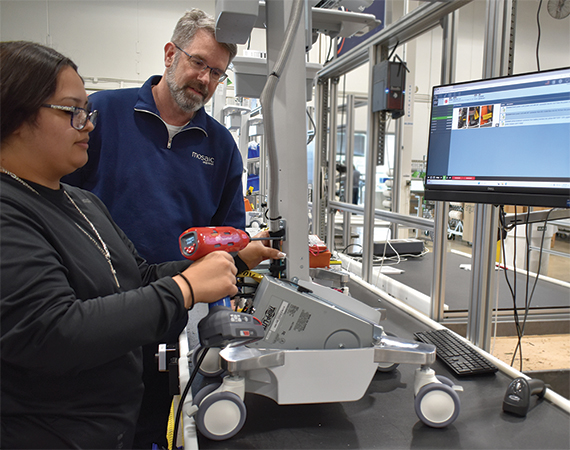To pass future FDA inspections, companies will need to meet all the requirements included in ISO 13485, though obtaining certification through an independent external audit is not mandatory.
For decades, medical device manufacturers and their suppliers have followed two sets of quality standards. To pass annual inspections by the Food and Drug Administration (FDA), they followed one set of guidelines. To earn medical-specific ISO certification, they followed another.
Earlier this year, the FDA finalized a rule that will align FDA requirements with the International Standard Organization’s medical device framework, known as ISO 13485:2016. When the new rule becomes effective in February 2026, companies with ISO 13485 certification will be well-positioned for FDA inspections.
Those companies will also broaden their access to customers that require suppliers to be ISO certified. It’s a win-win opportunity for manufacturers, and experts recommend they pursue ISO 13485 certification to take advantage of the new guidelines.
The value of taking the extra step
Enterprise Minnesota’s business growth consultants have been helping companies navigate the ISO 13485 process for years. One of these experts, Keith Gadacz, says the regulatory update offers a chance for companies to improve processes while expanding their potential pool of customers.
To pass future FDA inspections, companies will need to meet all the requirements included in ISO 13485, though obtaining certification through an independent external audit is not mandatory. Gadacz says manufacturers that go through the certification process will achieve two goals.
The first is preparation. He likens the certification and inspection process to competing in archery. “If you only shoot once a year when the judge shows up, you may not hit the target very often,” he says.
But if companies consistently strive to follow and document processes for their internal audits and then go through external audits each year to earn and maintain ISO 13485 certification, they will be ready for FDA inspection. “That will keep those skills sharp, and we can hit the target consistently, which makes it a lot easier when the FDA comes,” Gadacz says.
ISO 13485 certified companies also enjoy a competitive edge over those that do not hold certification, Gadacz says. Many OEMs require their suppliers to be certified, and even if they do not, certified companies show potential customers that they have outstanding quality systems. “If you have to comply with it anyway, why wouldn’t you go through the certification process so you can use it to earn more customers?” Gadacz says.
That’s exactly the thinking behind R&D Batteries’ decision to earn ISO 13485 certification. The Burnsville company designs and manufactures a wide range of batteries, including many for medical devices. “Our main focus is replacement batteries, and our main customers are biomed engineers or technicians that work on equipment that’s usually in hospitals such as heart defibrillators, infusion pumps, or baby scales that have battery backups,” says Christopher Noddings, R&D’s vice president of operations.
Noddings says ISO had been on the company’s radar for the last decade or so because it was becoming the industry standard. Many of R&D’s customers — when they were looking for new suppliers or recertifying vendors — would first ask if the company was ISO certified.
“That was just after COVID, and we needed some more projects. That’s when we decided to tackle ISO,” Noddings says.
The investment does open doors to opportunities that wouldn’t have been there if we didn’t have the ISO certification,” Noddings says. “I’d say it’s contributed to four, five, or six percent of our growth.”
A similar mindset drove Ergotron to seek ISO 13485 certification. Based in Eagan, Ergotron serves global markets with a range of products that display computers and keyboards designed to improve employee movement, including mobile workstations for clinical settings.
“None of our Ergotron-branded products are FDA registered, but because they can be used as componentry in other systems, that’s where we have a link into it. And that’s really where 13485 became a market advantage for us,” says John Berger, the company’s director of global quality.
“We can approach the largest and most globally recognized medical device manufacturers and say, ‘We can be a supplier to you. We’re ISO 13485 certified and FDA registered as a contract manufacturer of medical devices.’ That’s a recognized standard for them, and they understand that we have a quality system to support the type of needs that they might have,” Berger says.
Obtaining certification
Before going through certification, Noddings says R&D had a fairly informal environment. “We knew how to make batteries, and we knew how to have the best quality.” Obtaining certification required documenting every process. “Putting every single procedure that we have here in writing was our biggest challenge, and that’s where the majority of our effort was.”
Noddings says he and Julie Moldenhauer, R&D’s production and quality manager, devoted the bulk of their time for the better part of a year to certification and relied heavily on Gadacz for direction. “Keith helped us understand the procedure and how it tied to our business,” Noddings says.
R&D’s effort paid off during the company’s first post-certification FDA inspection. “We had an FDA inspector come through as we finished our first ISO audit. Anything the inspector asked, we had an ISO procedure to respond with,” Noddings says.
Ergotron had already earned ISO 9001 certification, but to broaden market appeal, the company decided to pursue ISO 13485 also. “We chose to integrate the ISO 13485 elements into our existing ISO 9001 certified system. So, we have one system that includes both elements, and all products that we design and make are built under the same system,” Berger says. “Even though some of them may not require it, they all get the benefit of it.”
Preparing the company for ISO 13485 certification required understanding the additional requirements and filling those gaps. “There’s more attention to certain things, such as lot traceability of product through the system,” Berger says. “Just understanding the gaps was over half the battle, and then closing the gaps was the rest of it.”
Gadacz helped Ergotron understand and fill those gaps, working with the company’s quality group that focuses on standards and internal audits. “Working with Keith, we took it on as a team. We would arrange and follow up and track the action on items,” Berger says.
It was important to Ergotron to ensure employees weren’t just handed a new set of standards without any input. “We also included the process owners. Our goal was to make them part of understanding what was required and part of creating it,” Berger says.
Ergotron also asked Gadacz to train the employees who serve as the company’s internal auditors. “He was helping our folks to become experts so that we could maintain it ourselves,” Berger says.
While obtaining certification was a challenge, Noddings says it was worth the effort. “It was a very large amount of work, and it does require us to take more steps than we would normally have, but it’s improved our overall business,” he says. “It’s very clean and very efficient, and we improve it every time we have a surveillance audit or we’re recertifying. We sharpen the edges a little bit each time.”
Return to the Summer 2025 issue of Enterprise Minnesota® magazine.


